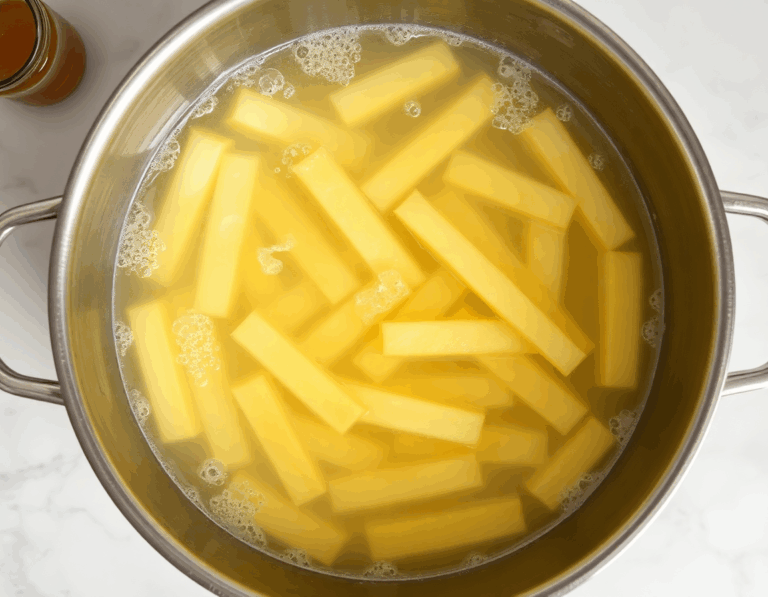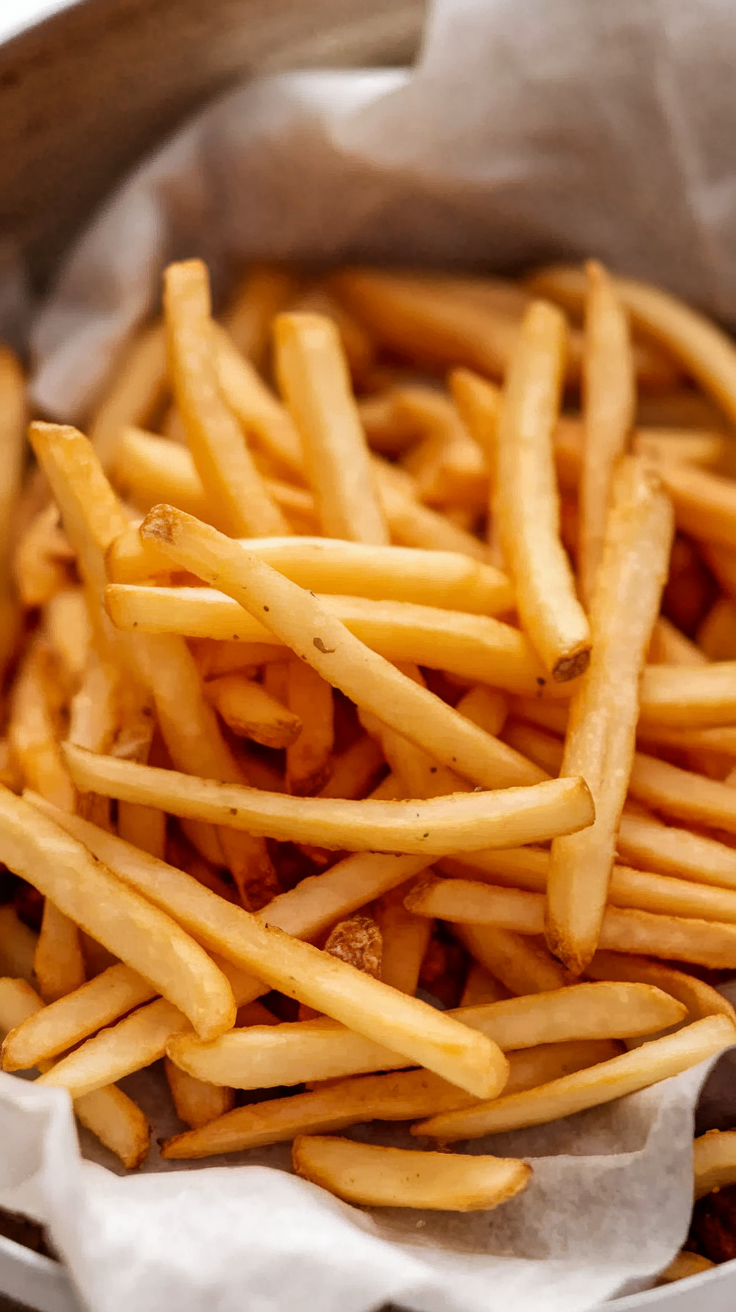Ah, the humble potato—so unassuming, yet bursting with potential. I remember the first time I tried making homemade fries, the kitchen filled with the intoxicating scent of sizzling oil and crispy perfection. It’s like discovering a new favorite song; you just can’t get enough. These fries, with their crunchy exterior and fluffy insides, have become my go-to comfort food, especially on lazy Sunday afternoons when the world feels a little slower.
Steps
- Begin by peeling the potatoes and cutting them into 6 mm (1/4 inch) thick fries using a serrated knife for a rougher texture that crisps well. Keep the cut fries submerged in water to prevent them from browning as you continue cutting.
- Rinse the cut fries under running water for 15-20 seconds to remove excess surface starch, which aids in achieving crispiness.
- In a large pot, bring cold water, vinegar, and salt to a boil with the fries, then reduce to a gentle simmer for 10 minutes. This step washes away excess sugars and activates starches, enhancing crispiness without disintegrating the potatoes.
- Drain the fries using a slotted spoon and spread them out on tea towel-lined trays to steam dry for 5 minutes.
- Prepare a pot with 3 cm (1.2 inches) of oil and heat it to 205°C (400°F). Fry the cut fries in three batches, pausing 10 seconds between adding portions to manage oil bubbling. Fry each batch for 50 seconds, then remove and let them cool on paper towel-lined trays for 30 minutes.
- After cooling, heat the oil again to 205°C (400°F) and fry half of the cooled fries for 4 minutes until golden brown and crispy. Repeat with the remaining fries, placing them in a paper towel-lined bowl.
- Sprinkle the freshly fried fries with salt or your preferred seasoning while they are still hot to ensure it adheres well. Toss the fries in the bowl to distribute the seasoning evenly. Enjoy your crispy homemade fries!

Ingredients
- 1 kg / 2 lb of starchy potatoes (e.g., Sebago, Russet, Maris Piper, or King Edward)
- 2 tablespoons white vinegar
- 1 tablespoon salt (for cooking)
- 1 liter / quart of canola or vegetable oil
FAQ
- Why do you use a serrated knife to cut the fries?
- A serrated knife creates a rougher surface on the fries, which increases the surface area. This leads to crispier fries because more of the surface can brown during frying.
- What is the purpose of simmering the fries in vinegar water?
- Simmering in vinegar water helps remove excess sugars from the potato surface, preventing premature browning. The vinegar also stabilizes the potato structure, preventing them from disintegrating during the simmering process.
- Why is it important to wait 10 seconds between batches when frying?
- Waiting 10 seconds between adding batches of fries to the oil allows the oil temperature to stabilize, reducing the risk of overflow due to excessive bubbling.
- Can you freeze the fries after the first fry?
- Yes, after the first fry, you can cool the fries completely and then freeze them. When you’re ready to eat, simply fry them again straight from the freezer for maximum crispiness.
- How can I ensure my fries stay crispy even after cooling?
- By following the method of rinsing, simmering in vinegar water, and double frying, the fries maintain their crispiness due to the removal of excess surface sugars and proper starch activation.
Tips
- Use a Serrated Knife: When cutting the potatoes, opt for a serrated knife. This creates a slightly rougher surface on the fries, increasing the surface area and resulting in a crispier texture.
- Simmer in Vinegar Water: Before frying, gently simmer the cut potatoes in a mixture of vinegar and water. This step helps remove excess sugars, ensuring the fries don’t brown too quickly and crisp up nicely. The vinegar also prevents the potatoes from disintegrating during the simmering process.
- Shallow Fry in Batches: To achieve perfect crispiness, shallow fry the fries in batches. Make sure there’s enough space in the pot to prevent overcrowding, which can lower the oil temperature and affect the texture.
- Season Wisely: Remember that the fries are already slightly salted from simmering in salted water. After frying, season them with your preferred seasoning or salt, but be cautious not to overdo it. Taste and adjust as necessary to enhance the flavor without overpowering it.
Equipment
- Serrated Knife – Used for cutting the potatoes into fries with a rougher surface for added crispiness.
- Heavy-based Pot – At least 10 cm / 4″ deep for shallow frying, ensuring safety headroom for oil bubbling.
- Cooking Thermometer – Essential for monitoring the oil temperature to achieve the perfect fry.
- Spider Strainer or Slotted Spoon – For safely adding and removing fries from the oil.
- Paper Towels – For draining excess oil from the fries.
